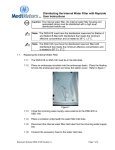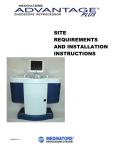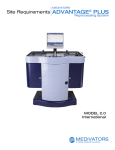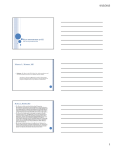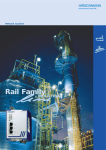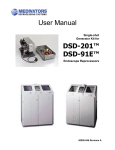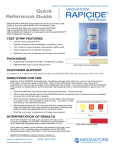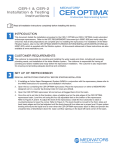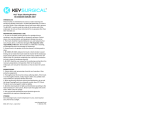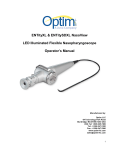Download 50097-064 Rev E
Transcript
SYSTEM OPERATION Run the Reprocessing Cycle 1. Place floating lid on the basin. Verify endoscope or hookup does not contact floating lid and close reprocessor lid. 2. Test HLD with test strips to confirm potency. 3. Press Station Select and choose Station A or B 4. Press ID DATA button and enter ID data: serial number, operator ID, patient ID, physician ID 5. Select disinfection program and press START 6. DSD Prompts: LCG Test Pass? “PRESS ENTER,” if test strip passed. Press “CANCEL” if failed; dump and replace HLD. 7. Verify fluid flows through hookups, endoscope channels and from distal end and that there are no leaks. DSD-201 Endoscope Reprocessing System Complete the Reprocessing Cycle 1. Open reprocessor lid when LCD Screen displays “Completed”. Confirm endoscope ID number on print out is correct, and “Completed” is documented. 2. Remove floating lid, disconnect hookup and remove endoscope. If any hookup component connection is loose or disconnected during the cycle, endoscope must be reprocessed. 3. Store hookup and reprocessed endoscope with all removable parts detached. End of Day Shutdown 1. Close incoming water line 2. Sanitize upper basins and basin lids with an EPA-registered sanitizer MAINTENANCE TROUBLESHOOTING Daily Maintenance Error Reports 1. Check and refill detergent reservoir if used 2. Clean detergent reservoir if using diluted solution 3. Refill alcohol reservoir if necessary 4. Wipe basins with lint-free cloth 5. Drain condensation from air tank (pull ring on tank) 1. Review interruptions caused by sensors: lid, fluid, air flow, basin level, reservoir levels 2. Error messages - see troubleshooting guide in DSD User Manual Weekly Maintenance 1. Lubricate the connector O-ring in the leak test hookup with silicone oil Three Months 1. Replace 1 micron and 0.45 micron water filters every 3 months or if below 40 psi 2. Replace air filter IN-SERVICE GUIDE DSD-201 & DSD201LT Six Months 1. Replace 0.2 micron water filter every 6 months or if below 40 psi and run waterline disinfection. 2. Replace vapor management filter (if applicable) FOR FACILITY USE ONLY Staff Name: Medivators Customer and Technical Support Toll Free: Phone: 1-800-444-4729 · www.medivators.com This Medivators guide, form, checklist or procedure is designed for use solely as a customer education tool, and is not intended to replace or in any way modify the Medivators User and Service Manuals. While Medivators training may be used in support of a facility’s overall competency program, it shall not constitute certification of facility personnel. Medivators shall in no event, be held responsible for a facility’s proper performance of endoscope reprocessing protocols or a facility staying current and compliant with ongoing instructional changes or corresponding training updates. Facility owners and operators of Medivators equipment are fully responsible for complying with industry standards and manufacturer’s proper use instructions. MEDIVATORS®, INTERCEPT® and RAPICIDE® are registered trademarks of Medivators Inc. All other company and product names listed may be trademarks of their respective owners. © 2015 Medivators Inc. All rights reserved. 50097-064-EN/E Training Date: Trainer: This In-Service training session is of vital importance to you and your staff. It is the only method of ensuring staff competency in the operation and understanding of this equipment. The level of understanding gained during this In-Service can have a direct effect on patient and staff safety. Please afford the time and attention required to ensure that you and your staff fully understand the training provided. INTENDED USE AND GUIDELINES Intended Use 1. Intended Use - high level disinfection of flexible immersible endoscopes 2. Operator Safety Overview - appropriate PPE - mask, gown, gloves, eye protection Guidelines for Reliable Disinfection 1. Detergent Solution - (optional) used in the pre-wash cycle. Must be low-foaming, free-rinsing, neutral in pH and used according to label instructions 2. Disinfectant Solution - required for high-level disinfection cycle 3. OLYMPUS®, PENTAX®, FUJIFILM®, KARL STORZ® - Endoscope cleaning and disinfection guidelines 4. SGNA, ASGE, ASTM, APIC and AORN - Endoscope cleaning and disinfection guidelines 5. SGNA approved reprocessing steps - Endoscope bedside pre-cleaning, leak testing, manual cleaning, high-level disinfection, final drying and storage standards and guidelines PRODUCT FAMILIARIZATION Endoscope Reprocessor Components and their Functions 1. Basin Components: lid, basin/station A&B, fluid inlet, basin connector, drain, overflow 2. Control Panel: keypad, function keys, LCD and LED indicators 3. Rear Components: incoming water, water filters, drain line, external water pressure regulator 4. Interior Components: water regulator, temperature control, chemical loading switch, transfer pump, air tank 5. Fluid Reservoirs: alcohol reservoir, disinfectant reservoir, detergent reservoir 6. Filters: disinfectant filter, air filter, water filter internal: 0.2 micron, external: 0.45 micron and 1 micron filters 7. Passive vapor management system (if applicable) 8. Active (charcoal) vapor management system (if applicable) 9. Printer, paper and ribbon (if applicable) Fluids and Test Strips 1. High-Level Disinfectant (HLD): RAPICIDE® OPA or Glutaraldehyde 2. Detergent: recommended detergent is MEDIVATORS INTERCEPT® detergent 3. Alcohol (70% Isopropyl): used to dry inside of endoscope channels 4. Test Strips: used to test the concentration of the HLD prior to each cycle FLUID LOADING AND UNLOADING High-Level Disinfectant (HLD), Detergent and Alcohol 1. Amount of HLD required: 4 gallons 2. Load disinfectant from basin or internal transfer pump 3. Disinfection cycle count (set-up 16) cycle warning/override (Set-up 7) 4. Draining HLD (dump) automatically or with internal transfer pump 5. Cleaning of disinfectant reservoir tank with lint-free cloth and water 6. Replacing disinfectant filters - at every disinfectant dump/load procedure 7. Perform a Set-up 16 to verify cycle count has reset to zero. Clearing cycle count (Set-up 11) 8. Load detergent and alcohol (if applicable) OPERATOR CONTROLS Control Panel 1. LED Indicators - alerts operator to system functions and errors. Status, Station, Cycle Phase, and Warning 2. LCD Screen - Displays system messages and prompts during system set up 3. Numeric Keypad - allows operator to enter numeric information 4. Function Keys - control the operation of the reprocessor. ID Data, Program Select, Add Air, Heater On, Disinfectant Dump, Set up, Enter, Station Select, Start, Stop, Cancel Program Set up and Functions 1. Program cycle time documentation 2. Review time remaining function (Set up 17) 3. Display disinfectant cycle count (Set up 16) 4. Check basin temperature setting (Set up 13) 5. Printing set ups (Set ups 33, 21 & 25) 6. Clear printer log (Set up 10) Perform for both A and B Station 7. Water line auto disinfection process (Set up 6) SYSTEM OPERATION Start-up 1. Verify power is on 2. Open incoming water line and verify water supply pressure into pre-filtration system is minimum of 40 psi. 3. If heat is required for HLD, allow 2 hours for reservoirs to reach proper temperature Daily Service 1. Check external pre-filters when unit is in operation and review filter log. Verify external water pressure regulator is delivering water at 35-40 psi during flush cycle. If not, check filters for replacement. 2. Check detergent and alcohol reservoirs fluid levels and refill if necessary 3. Check HLD expiration date and temperature 4. Inspect hookups for wear Prepare Endoscope for Reprocessing 1. Place endoscope in basin with control section in right rear of basin, light guide in left front, distal tip tucked and knob up 2. Locate proper hookup and connect-hookup to endoscope ports and basin connection. 3. Place accessory bag into basin away from drain 4. Attach leak tester hookup (if applicable) Endoscope Reprocessing Cycle Summary 1. Cycle Start-up Phase - monitoring of system sensors. Leak tester will inflate and monitor endoscope. 2. Soak Phase - water and detergent (if applicable) fill basin for soak and flush through channels 3. Disinfectant Phase - endoscope is flushed and soaked with high-level disinfectant (HLD) 4. Rinse Phase - basins fill with fresh water and channels are flushed with water, the number of rinses programmed is based on the HLD manufacturer’s Instructions-For-Use. 5. Alcohol Phase - alcohol is injected into channels, followed by air to assist in drying 6. Air Purge Phase - air is purged through channels to aid in drying





